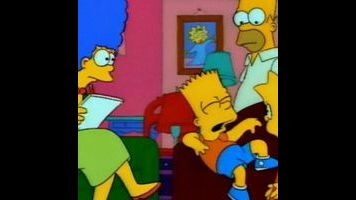The Simpsons (Classic): “Treehouse Of Horror III”

“Treehouse of Horror III” (season 4, episode 5; originally aired 10/29/1992)
According to the audio commentary on “Treehouse Of Horror III,” some of the creative folks at The Simpsons were concerned that the “Treehouse Of Horror” franchise had outworn its welcome and was rapidly running out of classic horror or science-fiction fodder to spoof. This was back in 1992. Though they obviously realized that these episodes were part of something wonderful and important and lasting, the writers and producers couldn’t have imagined that 20 years later “Treehouse Of Horror” wouldn’t just survive; it’d thrive as one of the most talked-about and watched episodes of every season of The Simpsons.
Writing a “Treehouse Of Horror”segment has to be both exhilarating and daunting. It’s exhilarating because it affords writers all the freedom in the world. In “Treehouse Of Horror” stories,characters could be whatever the show want or need them to be: giant apes, vampires, killer dolls, the whole gothic shebang. And it’s daunting because each segment has to tell a full, complete story in something like six minutes while doing justice to revered source material and including the non-stop laughs and genius gags that characterized The Simpsons in its god-like prime.
In time The Simpsons would, indeed, resort to spoofing such decidedly non-spooktacular fare like E.T and Mr. And Mrs. Smith (both in “Treehouse Of Horror XVIII”) but in 1992 the field was wide-open and the show could cherry-pick the most iconic and beloved fright fare of all time.
In “Treehouse Of Horror” episodes, the rules aren’t just different—they don’t even exist. If writers want Homer to kill Flanders or for a segment to end with a marriage between a woman and a giant ape, they can do so without worrying about continuity or consistency or fans griping that the gang is behaving out of character.
“Treehouse Of Horror III”’s framing device finds the good folks of Springfield telling stories during a Halloween party. The first tale of terror is, depending on your generation, either a spoof of a Twilight Zone episode featuring a doll that wants to kill Telly Savalas, the Zuni Fetish Doll segment of the revered TV-movie horror anthology Trilogy Of Terror or, for contemporary audiences and those with short attention spans, Child’s Play.
“Clown Without Pity,” as the segment is called, opens with Homer forgetting Bart’s birthday and jetting off at the last minute (or rather considerably after the last minute) to pick him up a present. Alas, Homer has the questionable judgment to go gift-shopping at House Of Evil, an establishment that bills itself as “Your one stop evil shop.” That should be a bit of a warning, as is the establishment’s name.
In the House Of Evil, Homer has a conversation with a shopkeeper modeled on the merchant whose grandson sells Gizmo to an unsuspecting family in The Gremlins. The writers may have created the character to pad out the episode, but he’s featured in one of the funniest exchanges in “Treehouse Of Horror III.” It’s a variation on the old vaudeville “That’s good, that’s bad” routine that goes a little something like this:
Shopkeeper: Take this object but beware. It carries a terrible curse.








































